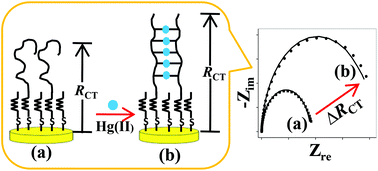Interactions of Hg(ii) with oligonucleotides having thymine–thymine mispairs. Optimization of an impedimetric Hg(ii) sensor†
Abstract
The present work describes the effect of the number of thymine–thymine mispairs in single strand DNA probes on Hg(II) interactions and further to develop a highly sensitive DNA based impedimetric sensor for Hg(II) detection. To achieve this goal, the influence of the number of T–T mispairs on the signal response prompted by DNA–Hg(II) binding interactions was examined on three designed DNA probes: 5′-OH-(CH2)6-S-S-(CH2)6-AGTCCACACGTTCCTTACGC-3′, 5′-OH-(CH2)6-S-S-(CH2)6-AGTCCACATTTTCCTTTTGC-3′, 5′-OH-(CH2)6-S-S-(CH2)6-AGTCCATTTTTTCCTTTTTT-3′ having 2T–T, 4T–T and 6T–T mispairs with identical length, respectively. This study revealed that the number of T–T mispairs plays a critical role in maximizing the signal intensity of DNA–Hg(II) binding interactions. Based on these results, DNA comprising maximum number of T–T mispairs was further utilized for construction of the Hg(II) sensor, which exhibited a linear correlation between the change in charge transfer resistance (ΔRCT) and the concentration of Hg(II) over the range of 1.0 × 10−5 M to 1.0 × 10−10 M with a lower detection limit of 3.2 × 10−11 M. The selectivity was tested against 12 different metal ions including Hg(II). The ΔRCT response from Hg(II) is 3 times higher than the nearest competitor Pb(II) and approximately 10 times than other ions. The potential application of such a robust and label-free DNA sensor was demonstrated by analyzing environmental samples collected from Lake Ontario.

- This article is part of the themed collection: CSC100: Celebrating Canadian Chemistry


 Please wait while we load your content...
Please wait while we load your content...